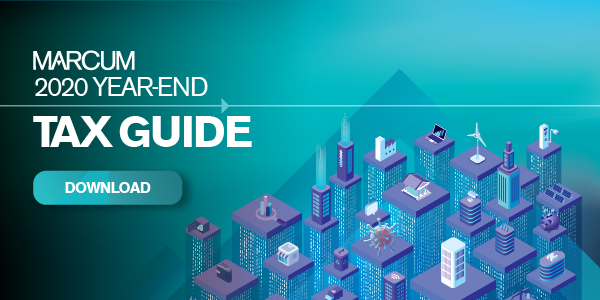Top Five Questions about the Paycheck Protection Program
In an effort to assist businesses suffering from the impact of the coronavirus pandemic, the Small Business Administration (SBA) created several economic relief programs. One such program was the Paycheck Protection Program (PPP). Much has been written about this program, which provides loans designed to incentivize small businesses to keep workers on the payroll. Loans will be forgiven if certain employee retention criteria are met and the funds are used for eligible expenses.
Since the loan program’s inception and its many iterations, the advisors at Marcum have addressed the concerns of our clients and the public through continuous Tax Flash updates, new content posted to our Coronavirus Resource Center, and a series of informational webinars. Several common questions concerning the PPP have surfaced through these channels. While we can advise and assist our clients in planning for some of these issues, for others we await guidance from the SBA and/or IRS.
The following are the five most common questions Marcum is routinely asked and our approach to each one:
How does loan forgiveness impact my tax return?
What makes the answer to this question interesting is that a PPP loan is not taxable income to the borrower, but the expenses eligible to qualify the loan for forgiveness are disallowed as deductions, unless the IRS changes its position on this matter. This means that a business will be required to reduce deductions on its tax return for expenses such as wages, employee benefits, retirement contributions, utilities, rent, and/or interest expense. In some cases, the disallowed expenses will equal the loan forgiven; in others it might not.
Presently, there is no definitive guidance from the regulators to indicate to which year the non-deductible expenses apply. Most borrowers will receive confirmation of loan forgiveness in 2021, while the applicable expenses were paid and incurred in 2020. There are also fiscal year filer concerns, as the covered period may span two filing years, and there is presently no guidance to indicate in which year or years to reduce those expenses. (A covered period is defined as the period during which the PPP funds are received and used and are eligible for forgiveness. For loans made on or after June 5, 2020, the forgiveness covered period is 24 weeks. For loans made before June 5, 2020, business owners can choose either an 8-week or 24-week loan forgiveness covered period.)
For planning purposes, while we all await guidance, we recommend that clients plan as if the expenses are not deductible. This conservative approach ensures that the correct taxes will be paid if it is ultimately determined that the expenses are not deductible. Further, if there is an opportunity to defer the reduction in deductions to next year, any tax overpayments can offset next year’s balances due.
How does wage reduction impact the research and development credit and the qualified business income deduction?
The short answer is that there is an impact, but we don’t have guidance on exactly what that impact is. The longer answer is that we have some ideas to consider while we await guidance. We recommend planning for the conservative approach, while recognizing potential options in case one of them becomes viable.
Both the research and development credit (R&D) and the qualified business income (QBI) deduction rely heavily on wages to determine taxpayer benefits. Since one of the non-deductible expenses for PPP forgiveness is wages, there will likely be a reduction in one or both of these calculations. Unless other guidance is issued, we recommend using as many costs as possible in the PPP forgiveness application to minimize the amount of wages that might be subject to reduction.
For example, 60% of PPP eligible expenditures must be payroll costs, which for PPP forgiveness purposes include company-paid health and retirement benefits. Since health and retirement benefit costs are not utilized to determine the R&D credit or QBI, these can be utilized in the forgiveness computation to the maximum extent and limit the inclusion of wages that might be subject to non-deduction.
Other questions arise pertaining to the allocation of remaining wages that might be used for R&D and QBI after the expense disallowance. For the R&D credit, there is no guidance related to wage reduction, since not everyone employed works in an R&D role. We suggest utilizing an allocation approach that would spread the impact across multiple departments. For example, if wages used for the PPP forgiveness calculation represent 15% of total wages, then reduce R&D wages by 15%.
For the QBI deduction, wages are one of several limits in place. The total deduction is 20% of net income and cannot be more than 50% of wages. A reduction in wages may not have a large impact this year because 20% of net income may still be lower than 50% of a reduced wages number. As this expense reduction may impact some businesses, we suggest potentially impacted businesses consider year-end tax planning.
How do I know which loan forgiveness application to use?
There are three different applications available for PPP loan forgiveness: the Standard Form, the EZ Form, and the S Form. All applicants can use the Standard Form, so the real questions surround when to use the EZ Form or the S Form.
The S Form can be used by a borrower with a PPP loan of $50,000 or less. However, if the borrower is affiliated with other companies, the total loans among those companies must be less than $2 million in order for the small borrower to be eligible to use this form.
The EZ Form can be used by borrowers if they can pass one of the three following tests:
- The borrower is self-employed with no employees and did not include any employee salaries in its PPP borrower application form. (This borrower will likely file an S Form.)
- The borrower did not reduce hourly rates or salaries by more than 25% when compared to the first quarter of 2020 hourly rates or salaries AND did not reduce the number of full-time equivalent employees between January 1, 2020, and the end of the covered period. (Note that the borrower may ignore reductions from an inability to rehire individuals for the unfilled positions or employees who refused employment restoration offers.)
- The borrower did not reduce hourly rates or salaries by more than 25% when compared to the first quarter of 2020 hourly rates or salaries AND the borrower was unable to operate at the same level of business activity due to guidance issued by the CDC, HHS, or OSHA. (Note that local governments acting in accordance with guidance issued by the CDC, HHS, or OSHA is used to determine ability to operate.)
Borrowers who do not meet the requirements for either of the above two forms will be required to file the standard loan forgiveness form.
Can I receive full forgiveness even though I could not maintain my full-time equivalent (FTE) employee count?
Yes, if sufficient qualified costs are incurred. The reduction in FTEs only reduces eligible costs, not the loan forgiveness amount. It’s a key difference that allows many businesses to avoid having a loan that requires repayment. Consider the following scenario:
| Loan Amount | $100,00 |
| Look back period FTEs | 10 |
| Covered period FTEs | 7 |
| Eligible expenses | 150,000 ($120,000 payroll, $30,000 non-payroll) |
Eligible expenses ($150,000) is reduced by the FTE reduction percentage (30%), which is $45,000, leaving $105,000 of net eligible costs ($150,000 – $45,000). Since $105,000 of eligible costs is still more than the loan amount of $100,000, the entire loan is still forgiven.
My business has been profitable this year. Will I have to repay all or part of my loan?
The answer is probably not, but it’s all based on facts and circumstances. When the business applied for the PPP loan, it certified that the current economic uncertainty made the loan request necessary to support ongoing operations. Since then, guidance has been issued indicating that loan amounts under $2 million were assumed to have met this economic uncertainty standard.
Therefore, if a loan is less than $2 million, the bright line test is passed, and business owners do not have to worry about 2020 profitability.
For loans in excess of $2 million, the borrower will likely have to demonstrate economic need. Note that many loan certifications were made at the beginning of the pandemic, when nobody knew what would happen in the weeks following the application, during which the loan proceeds needed to be used. We recommend businesses gather documents that support projections at the time of application, such as real-time discussions held among owners, diagrams and projections for what-if scenarios, what credit or equity facilities were available, and the anticipated economic impact of the repayment of other loans, for example. Of course, each business is unique in what information was available to it and the factors included in its decision-making process.
The above discussion reflects the five most common questions Marcum receives about PPP loan forgiveness. Until full answers are known, we suggest taking a practical, conservative planning approach while we await guidance from the authorities. We suggest consulting with your advisors about various scenarios and planning for several possibilities.







